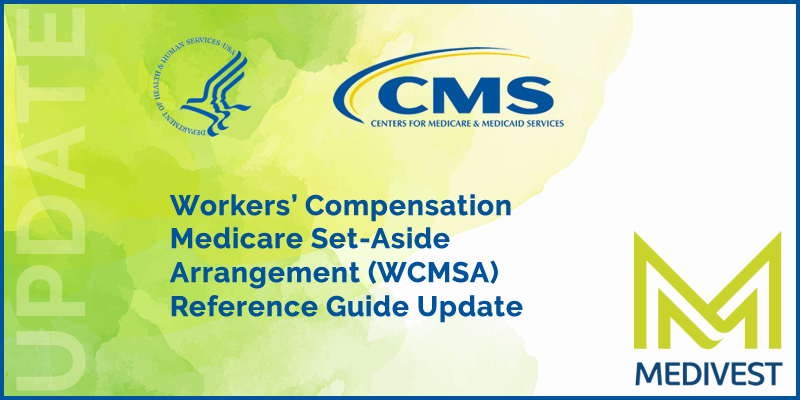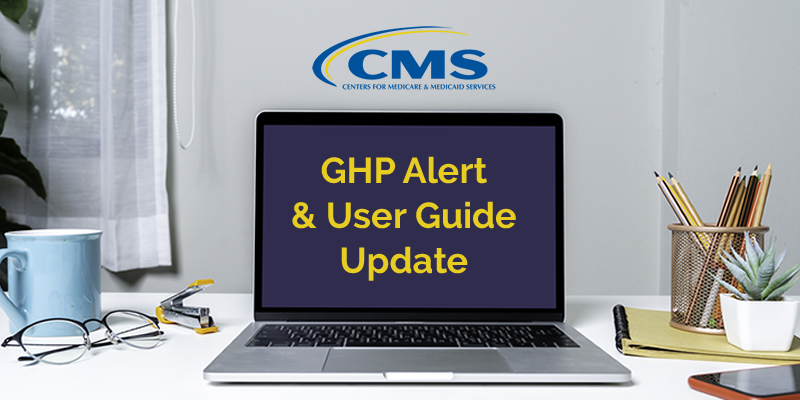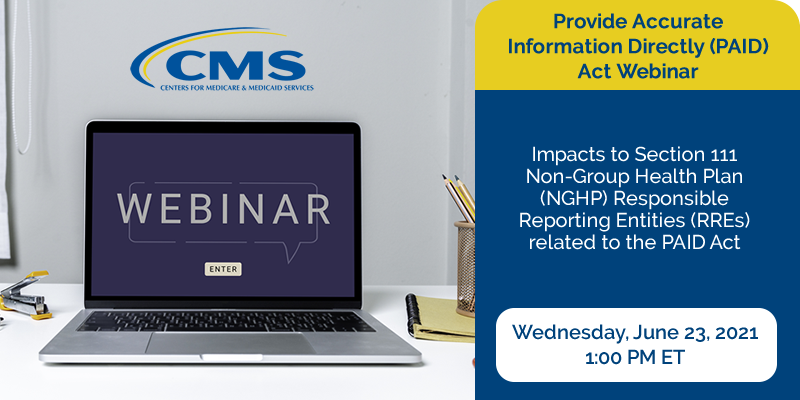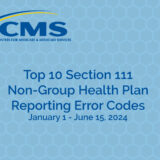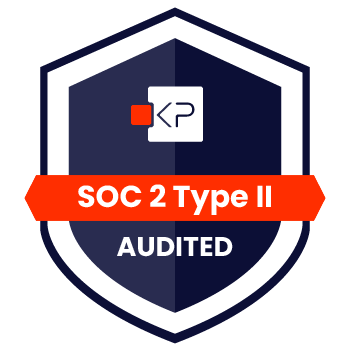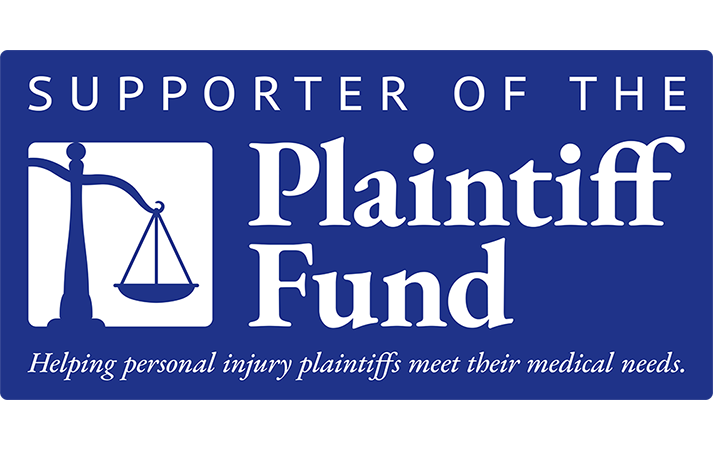The Centers for Medicare & Medicaid Services (CMS) released a revised Workers’ Compensation Medicare Set-Aside Arrangement (WCMSA) Reference Guide (“Reference Guide”) Version 3.3 on April 19, 2021. This Reference Guide replaces Version 3.2 which was released on October 5, 2020. There are a few notable changes when comparing the two Reference Guides. The blue highlights below indicate the updated changes provided in Reference Guide Version 3.3.
CMS’s Version 3.3 Reference Guide includes the following changes:
- The CDC Life Table link was updated (Section 3).
- Language around surgeries to be covered by seed money in a structured settlement was clarified, and a disclaimer was added to the proposal review reference tools list in Appendix 4, along with the Conduent Strataware® tool (Sections 5.2 and 9.4.4, Appendix 4).
- Miscellaneous clarifications were added as follows (Sections 9.4.5, 10.2, 16.2, and 4):
- On pricing: include refills when pricing intrathecal
- On documentation: clarification was added on Consent to Release
- On WCMSA Portal case access: clarification was added on case access for Professional Administrators who are not the original
- The Major Medical Centers table was updated for a Missouri entry (Appendix 7).
To download the new WCMSA Reference Guide v3.3 Click Here.
Change 1 – CDC Life Table Updated Link
Section 10.3
Please see the WCMSA site (http://go.cms.gov/wcmsa) for additional information.”
Change 2 – Seed Calculations Include Cost of First Surgery/Procedure for Each Injured Body Part
Section 5.2
Language around surgeries to be covered by seed money in a structured settlement was clarified.
- Medivest’s Takeaway: Of these announced changes, the change of most significance is the clarification that CMS expects seed calculations to be evaluated for each affect body part of an injured worker. Text has been inserted in multiple locations for this purpose. We have placed references to the applicable Reference Guide section where the updated language appears and have quoted various portions of the existing language along with the revised/inserted language for context below, with the revised language appearing in blue highlight.
- CMS’ Update: “A WCMSA can also be established as a structured arrangement, where payments are made to the account on a defined schedule to cover expenses projected for future years. In a structured WCMSA, an initial deposit is required to cover the first surgery or procedure for each body part, and/or replacement and the first two years of annual payments. The initial deposit (“seed money”) is followed by subsequent annual deposits (or a shorter time period if CMS agrees to such), based on the anniversary of the first deposit. If in any given coverage year, the deposited funds are not exhausted (i.e., used up, spent), they are carried forward to the next period and added to the next annual deposit. The whole fund, including carry-forwards, must be exhausted before Medicare will pay primary for any WC injury-related medical expenses. If the fund is exhausted appropriately in a given annual period, Medicare will pay primary for further WC injury-related medical expenses during that period. In the next annual period, the replenished WCMSA funds again must be used, until the WCMSA amount is appropriately exhausted.”
Section 9.4.4
- Medivest’s Takeaway: Slight changes were also made under 9.4.4 Medical Review, Step Six, to clarify that seed calculations are to be performed for each affected body part/injured area as follows:
- CMS’ Update – Section 9.4.4: “When annuity is selected, the submitter provides a proposed “seed” or initial deposit amount. This amount should include the cost of the first surgery/procedure for each body part, if any. The seed includes the first two years of the annual amount. See Section 05 – Cover Letter in this guide for instructions on how to calculate the seed amount, with an example.54r3efd
The seed includes the cost of the first surgery/procedure for each body part, including all costs such as prescription drugs, physician fees, anesthesia fees, and facility fees. If the surgery is preceded by an associated trial, i.e., trial SCS or trial intrathecal (IT) pump, the cost of the trial is also included since it is considered part of the same procedure. If there are no surgeries, the first procedure (if any, such as injections) is included. Series of spinal injections are not included, but series of knee visco supplementation are included if three are anticipated to be accomplished as a series of three weekly injections.
The first replacement of Durable Medical Equipment (DME), prosthesis, or orthotics is included in the seed funds if the cost of such items exceeds $500.
The seed includes the cost of surgeries, procedures, drugs, or replacement items as noted above. It does not include the cost of diagnostic studies, complications, and hospitalizations for non-surgical treatment.”
Other locations where the per body part is referenced include in 10.1 Section 05-Cover Letter:
on page 39:
. . .
“Note: Where the WCMSA is to be funded by a structured settlement, the cover letter
must disclose whether any portion of the projected prescription drug expenses has been included in the lump sum required to cover the first surgery/procedure for each body part,
and/or replacement and the first two years of annual payments.”
. . .
As well as in two places on page 40 under the same section:
“Example:
Total WCMSA = $301,826.90
Cost of first surgery for each body part, and/or the first procedure/replacement =
$10,191.40”
. . .
“Step 2. Identify the cost of the first surgery for each body part and the first
procedure/replacement ($10,191.40)”
Appendix 4-1 | WCRC Proposal Review Reference Tools
- CMS’ Update: “Strataware® is a tool, for repricing medical bills to state mandated fee schedules, as well as usual, customary and recommended (UCR) rates.”
Change 3 – Pricing Updates Includes refills when pricing intrathecal pumps
Section 9.4.5 | Medical Review Guidelines Intrathecal (IT) Pumps
Pricing clarification was updated for Intrathecal pumps to stress that pump refills should be projected for the claimant’s life expectancy.
- CMS Update: “The WCRC follows the most recent guidance from CMS on intrathecal (IT) pump pricing and frequencies. Permanent placement of IT pump devices are included every 7 years: the claimant’s life expectancy is divided by 7, decimals are dropped, and the whole number is used for determining replacement over the life expectancy. Pricing includes necessary pump refills over the claimant’s life expectancy.”
“Pricing for Spinal Cord Stimulator (SCS) Surgery
. . .
Consider the number of leads to be used.
Analysis Services: CMS LCDs (L34705 and L35648) can be billed every 30 days and more frequently in the first month. It should be priced four times in the first 30 days, monthly for the first year, and twice a year after the first year.
5. LCD L34705 – SCS (Dorsal Column Stimulation) – “Generally, electronic analysis services (CPT codes 95970, 95971, 95972, and 95973) aren’t considered medically necessary when provided more often than once every 30 days. More frequent analysis may be necessary in the first month after implantation.”
6. LCD L35648 – SCS for Chronic Pain – Under Utilization Guidelines: “Generally, electronic analysis services (CPT codes 95970, 95971, 95972 and 95973) aren’t considered medically necessary when provided more often than once every 30 days. More frequent analysis may be necessary in the first month after implantation.
Section 10.2 | Consent to Release Note
- CMS’ Update: “Consent to Release documents must be signed (by hand or electronically) with the full name of either the claimant, matching the claimant’s legal name, or by the claimant’s authorized representative, if documentation establishing the relationship is also provided. It must be a full signature, not initials.”
Section 16.2 | Amended Review
On WCMSA Portal case access: clarification was added on case access for Professional Administrators who are not the original submitter.
- CMS’ Update:
- In the event that treatment has changed due to a state-specific requirement, a life-care plan showing replacement treatment for denied treatments will be required if medical records do not indicate a change. Requests for changes to treatment plans will not be accepted without supporting medical documentation.
- The approval of a new generic version of a medication by the Food and Drug Administration does not constitute a reason to request an amended review for supposed changes in projected pricing. CMS will deny the request for re-review if submitters fail to provide the above-referenced justifications with the request for re-review. Submitters will not be permitted to supplement the request for re-review, nor will they be developed.
- Re-review and amended review requests may be made electronically or by mail.
See the WCMSAP User Guide at https://www.cob.cms.hhs.gov/WCMSA/assets/wcmsa/userManual/WCMSAUserManual.pdf for details on electronic submission. Professional Administrators who are not the original submitter, see Section 19.4.
Section 19.4 | Change of Submitter
Provides Helpful Information to Professional Administrators that did not submit the WCMSA on How to Gain Access on the WCMSA Portal case access: clarification was added on case access for Professional Administrators who are not the original submitter.
- CMS’ Update: Professional Administrators whose EIN does not match the EIN of the original submitter, contact BCRC to gain access to the case via the WCMSA Portal; otherwise you must submit by mail. Submitter changes will not be accepted after settlement, and does not constitute a reason for a re-review (See Section 16.0 for re-review requirements). CMS will not provide copies of existing documentation to the new submitter. Any documentation must be obtained from the incumbent submitter or insurer.”
Change 4 – The Major Medical Centers table was updated for a Missouri entry (Appendix 7)
Click Here for the updated list of Major Medical Centers by State, NPI, and ZIP Code with the new Missouri entry.
Medivest will continue to monitor changes occurring at CMS and will keep its readers up to date when such changes are announced. For questions, feel free to reach out to the Medivest representative in your area by clicking here or call us direct at 877.725.2467. For any specific questions regarding MSAs of any type click here.



